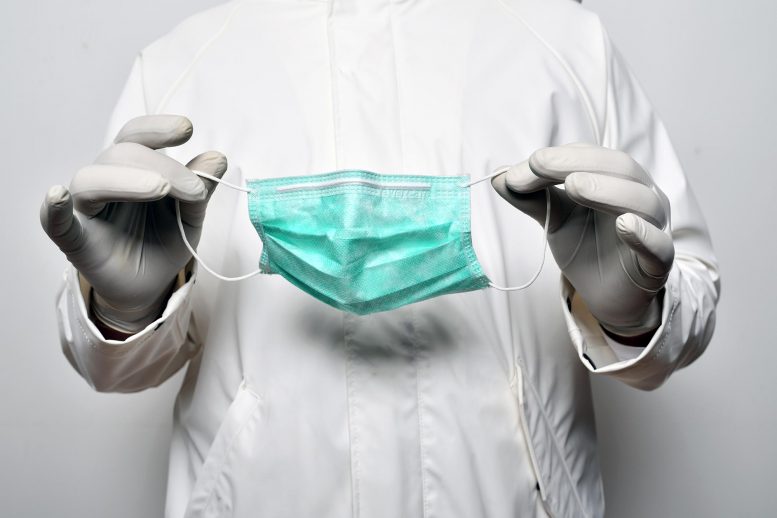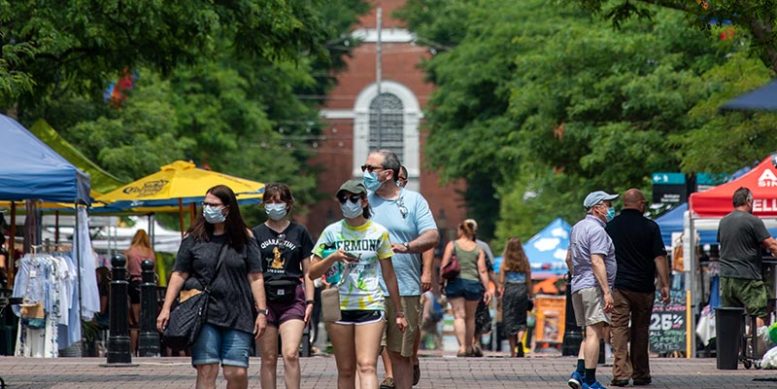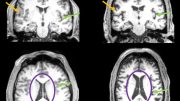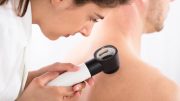
The message that people need to wear a mask is essential but insufficient. It should be coupled with education that masks do not grant unlimited social interactions. Strictly limiting your contacts is still necessary.
A unique new study suggests that the behavior public officials are now mandating or recommending unequivocally to slow the spread of surging COVID-19 — wearing a face covering — should come with a caveat. If not accompanied by proper public education, the practice could lead to more infections.
The finding is part of a unique study, just published in JMIR Public Health and Surveillance, that was conducted by a team of health economists and public health faculty at the University of Vermont’s Larner College of Medicine in partnership with public health officials for the state of Vermont.
The study combines survey data gathered from adults living in northwestern Vermont with test results that showed whether a subset of them had contracted COVID-19, a dual research approach that few COVID studies have employed. By correlating the two data sets, researchers were able to determine what behaviors and circumstances increased respondents’ risk of becoming sick.
The key risk factor driving transmission of the disease, the study found, was the number of daily contacts participants had with other adults and seniors.
That had relevance for two other findings.
Those who wore masks had more of these daily contacts compared with those who didn’t, and a higher proportion contracted the virus as a result.

A unique new study suggests that the behavior public officials are now mandating or recommending unequivocally to slow the spread of surging COVID-19 — wearing a face covering — should come with a caveat. If not accompanied by proper public education, the practice could lead to more infections. Credit: Joshua Brown
Basic human psychology could be at work, said Eline van den Broek-Altenburg, an assistant professor and vice chair for Population Health Science in the Department of Radiology at the Larner College of Medicine and the study’s principal investigator.
“When you wear a mask, you may have a deceptive sense of being protected and have more interactions with other people,” she said.
The public health implications are clear. “Messaging that people need to wear a mask is essential, but insufficient,” she said. “It should go hand in hand with education that masks don’t give you a free pass to see as many people as you want. You still need to strictly limit your contacts.”
Public education messaging should make clear how to wear a mask safely to limit infection, van den Broek-Altenburg added.
The study also found that participants’ living environment determined how many contacts they had and affected their probability of becoming infected. A higher proportion of those living in apartments were infected with the virus compared with those who lived in single-family homes.
“If you live in an apartment, you’re going to see more people on a daily basis than if you live in a single-family home, so you need to be as vigilant about social distancing,” van den Broek-Altenburg said.
The study controlled for profession to prevent essential workers, who by definition have more contacts and are usually required to wear masks, from skewing the results.
“It’s generally known that essential workers are at higher risk, and our study bore that out,” van den Broek-Altenburg said. “We wanted to see what else predicted that people were going to get sick,” she said.
Reported cases in Chittenden County, Vermont only one-fifth of likely total
The study provides the first estimate of unreported cases in Vermont’s Chittenden County, where most study participants live. The survey found that 2.2 percent of the survey group had contracted the virus, suggesting that an estimated 3,621 Chittenden County residents were likely to have become ill, compared with just 662 reported cases, just 18%.
That figure translates to a hospitalization rate of 1.2% and adjusted infection fatality rate of 0.55%.
This finding is important for policy-makers, van den Broek-Altenburg said, in and out of Vermont.
“If you know how many people are sick or have been sick, you’re much better equipped to make precise predictions of will happen in the future and fashion the appropriate policies,” she said.
It also shows the importance of serologic and PCR testing of the general population, she said.
“If you only test symptomatic patients, you’ll never be able to find out how many people have already had the virus. With our random sample study we were able to show that Vermont has so far only tested less than one-fifth of the people who have likely had the virus. To capture the larger population, random samples of the population are needed so we can also capture asymptomatic patients, which appears to be the majority of COVID-19 cases.”
The study, among other things, is a proof of concept, van den Broek-Altenburg said.
“I hope it leads to other, larger studies that combine survey data with widespread testing. This approach is essential to both understanding the dynamics of this pandemic and planning our response to futures ones.”
Ten of the 454 survey respondents who took the serologic test had antibodies for COVID-19, and one tested positive for the virus. Given the small number, researchers simplified their models and were able to reach a high confidence level in the two key findings.
“We tested our models and found that the results were robust through several different model specifications,” van den Broek-Altenburg said.
To create the study group, the researchers sent a survey to 12,000 randomly selected people between the ages 18 and 70 who had at least one primary care visit at the University of Vermont Medical Center, which services primarily northwestern Vermont, in the past three years.
Reference: “Jobs, Housing, and Mask Wearing: Cross-Sectional Study of Risk Factors for COVID-19” by Eline M van den Broek-Altenburg, MA, MSc, PhD; Adam J Atherly; Sean A Diehl, PhD; Kelsey M Gleason, DrSc; Victoria C Hart, PhD; Charles D MacLean, MD; Daniel A Barkhuff, MD; Mark A Levine, MD and Jan K Carney, MD, 11 January 2021, JMIR Public Health and Surveillance.
DOI: 10.2196/24320
Coauthors on the study include Eline van den Broek-Altenburg, University of Vermont Larner College of Medicine, Department of Radiology; Adam Atherly, University of Vermont Larner College of Medicine, Center for Health Services Research; Sean Diehl, University of Vermont Larner College of Medicine, Microbiology and Molecular Genetics; Kelsey Gleason University of Vermont Larner College of Medicine; Victoria Hart, University of Vermont Larner College of Medicine; Charles MacLean, University of Vermont Larner College of Medicine; Daniel Barkhuff, University of Vermont Larner College of Medicine, Emergency Department; Mark Levine, University of Vermont Larner College of Medicine, Department of Medicine; Jan Carney, University of Vermont Larner College of Medicine, Department of Medicine.
Editor’s Note: The headline has been changed to highlight the importance of the right messaging. Previously it was: “Surprising New Study Finds That People Who Wear Masks Are More Likely to Become Infected With COVID-19 Than Those Who Don’t.”









The conclusions of this study could not be more irresponsible and unscientific.
The data is not weighted for other factors. Are the individuals wearing the masks outside work going to the supermarket or other public places after work? For example, I wear a mask if I am going to public space after work; but if I am driving home directly I don’t wear the mask. Therefore I am more exposed to infection when wearing the mask. This does conclude that wearing masks increases the chance of infection.
Northwestern Vermont? If you look at the map, there is nothing in that region. It is mostly rural. How can you extrapolate these findings to urban areas, cities?
I cannot believe that the conclusions are based on ten, yes, only ten, positive individuals out of 454 tested subjects.
The paper should be withdrawn from the publication.ScienTechDaily should not be echoing such unprofessional article. It sends a wrong and dangerous message.
You’re confused. Perhaps read the study.
And it all makes logical sense too:
– Obviously the fewer people you are around, the less likely you are to come in contact someone that is COVID-19 positive and infectious. If you don’t go near an infectious person, you aren’t going to catch it.
– If you believe a mask is giving you protection, of course you’re more likely to go out in public and visit friends and family.
– A mask is not providing significant filtering of small particles to provide much protection. COVID-19 is transmitted primarily by fine aerosols that linger in the air, not large particles that typical masks filter. In fact, breathing through a cloth mask can generate more small particles than not wearing any mask.
https://scitechdaily.com/some-masks-can-be-worse-than-not-wearing-one-at-all-physics-of-how-masks-affect-airflow-and-covid-19-protection/
https://scitechdaily.com/new-testing-shows-masks-not-enough-to-stop-covid-19s-spread-without-social-distancing/
https://scitechdaily.com/seeing-is-believing-comparing-facemask-effectiveness-in-mitigating-transmission-of-covid-19/
Vaccine went through based on less than 200 cases.
“Social distancing” has, from the very beginning of the pandemic, been the #1 recommendation. Then someone over-interpreted the findings about aerosolized COVID-19 particles and everyone decided that we had to wear masks any time we were outdoors. And as the clamor about mask-wearing grew louder, people forgot about social distancing.
I really hope that the findings of this paper get reported intelligently. Unfortunately, the title of this article suggests that will not happen. Congrats on confusing millions.
The title of this article is misleading. It should be “Masks alone are not enough”.
Malarkey! You’re one who simply believes in masks because you’ve been programmed to do so.
This study found that masks weren’t important, as wearing one or not wasn’t statistically significant for catching COVID-19. What was important was social distancing.
So a better headline would be that “Masks don’t help and in fact your incorrect confidence in their protection leads you to engage in behavior that makes it more likely that you will get COVID-19.” But that would be too long.
Believe in science, even when it contradicts your assumptions.
This PR article was paid by Trump-et or by Giuliany?
This PR article was paid by Trump-et or by Rudy?
The title is very misleading and gives ammo to anti-maskers who only read headlines. “Mask Is No Substitute For Social Distancing” would be much better. When I saw the headline I thought it was an article that would be supporting the anti-maskers. I do think it’s irresponsible to do, then publish studies on such an important matter when the sample sizes are miniscule compared to what’s being studied. This didn’t even cover a drop in the bucket. Very irresponsibly written without all the details as well, leading to too much speculation and drawing of incorrect and mislead conclusions.
The click-bait title is misleading because the correlation is not due to the masks. This is simply another example of phenomena that goes by names such as the rebound effect, halo effect or Peltzman effect/risk compensation.
This just in: Stupidity is the leading factor in all infections. The people who pull at their mask and fidget with it destroy any of their efforts. Keep your hands away from your face and leave the mask alone. How many of the participants used clinically sound procedures for donning PPE?
The only people to benefit from this dis-information is China. Keep supporting crap like this and you will be speaking Mandarin soon.
What a misleading headline. The editors should be ashamed of themselves.
If you really had any facts behind you, you would be specific. However, you are wrong as the article and scientific study back up the headline.
It is there plain as day: People who wear masks are more likely to catch COVID.
I repeat, for all these commenters that have trouble reading:
### People who wear masks are more likely to catch COVID. ###
Telling people to “wear a mask” is inferring that they provide protection, when they do not. You must limit your contact with other adults and seniors. (Not go over to their house but try to stand 6 feet apart either.)
blahh blahh blahh just stay freakin home if u don’t like mask soo much dude lameee if really read the article like most did u would conclude that u need to stay home!!
The thing is, those who like masks should stay home because they’re the ones who are afraid to catch the virus the most. But they’re so busy going around and seeking those who aren’t wearing a mask. Afraid? Stay home and have your wear put on while you’re at home. Otherwise – shut down, you’r nobody to tell other what to do.
The people with no mask are still too patient, but they may begin to act — start cheezing and coughing at you, on purpose. What will you say then?
Horribly misleading headline. This is definitely an article that should NOT be in any media purporting to be related to science. Shameful.
Are you sure your name isn’t Karen? You just want to tell people to “wear a mask” because CNN and MSNBC brainwashed you into believing that, even though this scientific study shows you that your belief is wrong. Shameful. And stupid.
is your name ThE MaLe VeRsIoN Of A KaReN? just wondering cause wow talk about hypocrisy. (your not funny man lol)
A suggestion: RTFA
From the article: “ It is plausible that mandating masks could be counterproductive if the increased risk associated with an increase in contacts is larger than the decrease in risk associated with mask wearing. That is, it is possible masks may provide a false sense of security that leads to people letting their guard down and trusting the mask more than is warranted. Further research into the effectiveness of masks and behavioral responses to mask mandates is urgently needed.”
Example:
Everyone in UAE is wearing a mask. There’s the fine of 1k usd for not wearing one.
Despite that, UAE has been seeing over 1k, even 2-3k more recently, new infections discovered daily and since around July 2020
There’re other similar examples.
Question: if masks are so useful, why 1k-2k-3k new transmissions daily?
The title is so misleading
It seems irresponsible to title this article this way, it invokes the thought in people title surfing that they shouldn’t wear masks and masks are dangerous. I know the article itself isn’t suggesting that, but with popularity of people not actually reading articles and only taking the title, this feels like intentional misinformation.
The study assumes that masks must be helpful, and that the increased infections must be caused by behavioral changes as people engage in more contacts. Maybe the basic problem is the mask itself.
Most masks will block droplets, but as they quickly become contaminated, they may potentially disperse viral and bacterial contaminants as fine aerosols.
Randomized trials with surgical masks in a home or medical settings are pretty much equivocal, and cloth masks perform worse than surgical masks. Here is one of the largest randomized trials of surgical masks in a public setting – a religious pilgrimage.
For these reasons, they were not widely recommended for the general public during viral outbreaks for the past century.
The link to the randomized trial on mask wearing and influenza at the religious pilgrimage is: https://papers.ssrn.com/sol3/papers.cfm?abstract_id=3349234
(It is a preprint, first released in 2019.)